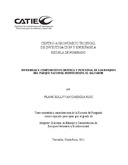Mostrar el registro sencillo del ítem
Diversidad y composición florística y funcional de los bosques del Parque Nacional Montecristo, El Salvador
| dc.contributor.author | Cardoza Ruíz, Frank S. | |
| dc.date.accessioned | 2014-10-20T04:40:42Z | |
| dc.date.available | 2014-10-20T04:40:42Z | |
| dc.date.issued | 2011 | es_ES |
| dc.identifier | 475798 | es_ES |
| dc.identifier.uri | https://repositorio.catie.ac.cr/handle/11554/4815 | |
| dc.description | Tesis (Mag.Sc.) -- CATIE, 2011 | es_ES |
| dc.description.abstract | el enfoque de ecología funcional contribuye a entender mejor los procesos ecosistémicos claves en estos bosques tropicales de El Salvador. Se estudió la estructura, composición florística y diversidad funcional de los bosques del Parque Nacional Montecristo, en el occidente-norte de El Salvador. Se identificó un total de 43 especies indicadoras distribuidas en los cuatro tipos de bosques, siendo el bosque nublado el de mayor especies (19) y los bosques pino-encino y mixto alto los que mejor se diferenciaron al presentar una clara dominancia de tres especies en cada bosque. El bosque en donde las especies modeladas se distribuyeron en mayor área fue el mixto y la menor área estuvo en la transición de bosque mixto bajo a mixto alto. El área de estudio constituye un refugio natural importante para la conservación de algunas especies raras o amenazadas a nivel regional. Se debería dar seguimiento a largo plazo (en estas mismas parcelas) para observar los posibles cambios en la estructura y composición de estos bosques debido a potenciales cambios por el cambio climático que afectarán las distribuciones de los TFPs The structure, floristic composition and functional diversity of the forests of Montecristo National Park in the northwestern area of El Salvador were studied. A total of 43 indicator species were identified being distributed in the four types of forests. Cloud forests were the most numerous species (19) and the pine-oak and mixed high the ones that best differentiated presenting a clear dominance of three species in each forest. The forest where modeled species were distributed in a highest area was the mixed one area and the lowest area was the transition area between the mixed forest and the mixed high forest. The study area is an important natural refuge for the conservation of rare or endangered species at the regional level. Monitoring should be followed in a long term (in the same plot) to observe possible changes in the structure and composition of these forests to potential climate changes that will affect the distributions of PFTs. The functional ecology approach helps to better understand key ecosystem processes in these tropical forests of El Salvador. | es_ES |
| dc.language.iso | es | es_ES |
| dc.publisher | CATIE, Turrialba (Costa Rica) | es_ES |
| dc.relation.ispartof | Proyecto Finnfor I y Finnfor II - CATIE | |
| dc.relation.ispartof | Magister Scientiae en Manejo y Conservación de Bosques Tropicales y Biodiversidad | |
| dc.rights | info:eu-repo/semantics/openAccess | |
| dc.subject | BOSQUES | es_ES |
| dc.subject | BIODIVERSIDAD | es_ES |
| dc.subject | COMPOSICION BOTANICA | es_ES |
| dc.subject | PARQUES NACIONALES | es_ES |
| dc.subject | ECOSISTEMA | es_ES |
| dc.subject | COMPOSICION FLORISTICA | es_ES |
| dc.subject | ESTRATEGIA PARA LA CONSERVACION | es_ES |
| dc.subject | CAMBIO CLIMATICO | es_ES |
| dc.subject | GRADIENTES ALTITUDINALES | es_ES |
| dc.subject | RASGOS FUNCIONALES | es_ES |
| dc.subject | EL SALVADOR | |
| dc.title | Diversidad y composición florística y funcional de los bosques del Parque Nacional Montecristo, El Salvador | es_ES |
| dc.type | Tesis | es_ES |
| dcterms.rights | acceso abierto | es_Es |
| dc.identifier.publication | Turrialba (Costa Rica) | es_ES |
Ficheros en el ítem
Este ítem aparece en la(s) siguiente(s) colección(ones)
-
Tesis [3046]


